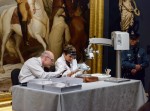 The time capsule excavated out of the cornerstone of the Massachusetts Statehouse in Boston last month was opened on Tuesday in front of dignitaries and press at the Museum of Fine Arts. Before the assembled audience including members of the press, Governor Deval Patrick and Secretary of the Commonwealth William Galvin, MFA conservator Pam Hatchfield and Michael Comeau, Executive Director of the Massachusetts Archives, carefully pried open the lid of the 5-1/2 x 7-1/2 x 1-1/2″ box against the fitting backdrop of Thomas Sully’s monumental 1819 painting of George Washington and his ragtag army crossing the frozen Delaware River, The Passage of the Delaware, in the museum’s Art of Americas wing.
The time capsule excavated out of the cornerstone of the Massachusetts Statehouse in Boston last month was opened on Tuesday in front of dignitaries and press at the Museum of Fine Arts. Before the assembled audience including members of the press, Governor Deval Patrick and Secretary of the Commonwealth William Galvin, MFA conservator Pam Hatchfield and Michael Comeau, Executive Director of the Massachusetts Archives, carefully pried open the lid of the 5-1/2 x 7-1/2 x 1-1/2″ box against the fitting backdrop of Thomas Sully’s monumental 1819 painting of George Washington and his ragtag army crossing the frozen Delaware River, The Passage of the Delaware, in the museum’s Art of Americas wing.
The collection, originally in a cowhide pouch, was first placed at the cornerstone by then-Governor of Massachusetts Samuel Adams, silversmith patriot Paul Revere and militia Colonel William Scollay at the dedication of the building in 1795. It was rediscovered during repair work on the Statehouse foundations in 1855 after which officials added a few pieces of their own before sealing the artifacts in a new metal box that was mortared into the underside of the cornerstone.
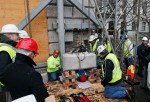 Technically, it’s not a time capsule because they are deliberately intended to be reopened at some point in the future. This was a foundational offering, part of an ancient tradition of depositing ritually significant objects under new buildings. The original deposit was made at the culmination of a Masonic ceremony celebrating the laying of the cornerstone held on July 4th, 1795. That’s why Paul Revere and William Scollay were so prominently involved: Revere was the “Most Worshipful Grand Master” and Scollay the “Right Worshipful Deputy Grand Master” of the Grand Lodge of Massachusetts. Governor Adams invited the Grand Lodge to perform the cornerstone ceremony, a traditional Masonic ritual that has been performed for hundreds of years, one of only two Masonic rituals that is performed in public (the other is a funeral).
Technically, it’s not a time capsule because they are deliberately intended to be reopened at some point in the future. This was a foundational offering, part of an ancient tradition of depositing ritually significant objects under new buildings. The original deposit was made at the culmination of a Masonic ceremony celebrating the laying of the cornerstone held on July 4th, 1795. That’s why Paul Revere and William Scollay were so prominently involved: Revere was the “Most Worshipful Grand Master” and Scollay the “Right Worshipful Deputy Grand Master” of the Grand Lodge of Massachusetts. Governor Adams invited the Grand Lodge to perform the cornerstone ceremony, a traditional Masonic ritual that has been performed for hundreds of years, one of only two Masonic rituals that is performed in public (the other is a funeral).
The massive granite cornerstone was transported in a procession from the Old State House to the site of the new one on a wagon drawn by 15 white horses, one for each of the states in the Union. When it arrived, a troop of fusiliers gave a 15-gun salute and Governor Adams, Paul Revere and William Scollay lay the pouch between two sheets of lead under the cornerstone. Adams declared the building to be constructed upon this stone should be “fixed, unimpaired, in full vigor, till time shall be no more” and Revere gave a supermasonic speech linking the foundation of the new statehouse to the founding of the nation.
Worshipful Brethren, I congratulate you on this auspicious day: — when the Arts and Sciences are establishing themselves in our happy Country, a Country distinguished from the rest of the World, by being a Government of Laws. — Where Liberty has found a Safe and Secure abode, — and where her Sons are determined to support and protect her.
Brethren, we are called this day by our Venerable + patriotic Governor, his Excellency Samuel Adams, to Assist him in laying the Corner Stone of a Building to be erected for the use of the Legislature and Executive branches of Government of this Commonwealth. May we my Brethren, so Square our Actions thro life as to shew to the World of Mankind, that we mean to live within the Compass of Good Citizens that we wish to Stand upon a Level with them that when we part we may be admitted into that Temple where Reigns Silence & peace.
When the artifacts were recovered and reburied in 1855, the Grand Master of the Lodge was asked to do the honors again.
![]() The metal box has been in the MFA laboratory for the past three weeks being examined with non-invasive techniques so conservators had an idea of what to expect when they opened it. X-rays revealed that, as expected, there were coins, a metal plaque and papers inside. X-ray fluorescence determined that the box itself was not copper but rather brass, as are all eight of the screws keeping the capsule shut.
The metal box has been in the MFA laboratory for the past three weeks being examined with non-invasive techniques so conservators had an idea of what to expect when they opened it. X-rays revealed that, as expected, there were coins, a metal plaque and papers inside. X-ray fluorescence determined that the box itself was not copper but rather brass, as are all eight of the screws keeping the capsule shut.
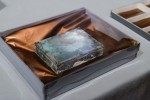 Pam Hatchfield, who had spent six hours on her back in the snow chiseling out the box from the cornerstone, then had more chiseling to do. She removed chunks of plaster from the top of the box and carefully dug away at the plaster around the heads of the screws. A little solvent was applied to help loosen the screws as well. Hatchfield turned her attention to the lead solder sealing the edges of the lid to the box, chiseling it away so the box would actually be openable at the press conference.
Pam Hatchfield, who had spent six hours on her back in the snow chiseling out the box from the cornerstone, then had more chiseling to do. She removed chunks of plaster from the top of the box and carefully dug away at the plaster around the heads of the screws. A little solvent was applied to help loosen the screws as well. Hatchfield turned her attention to the lead solder sealing the edges of the lid to the box, chiseling it away so the box would actually be openable at the press conference.
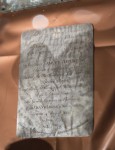 When the lid was removed, the first artifacts they found were five folded newspapers from the 19th century. Under them were 23 silver and copper coins dating from 1652 to 1855, a copper medal depicting George Washington, a title page from the Massachusetts Colony Records, a number of calling cards, the seal of the Commonwealth and lastly, a silver plaque inscribed by Paul Revere marking the cornerstone ceremony that still has visible fingerprints on it.
When the lid was removed, the first artifacts they found were five folded newspapers from the 19th century. Under them were 23 silver and copper coins dating from 1652 to 1855, a copper medal depicting George Washington, a title page from the Massachusetts Colony Records, a number of calling cards, the seal of the Commonwealth and lastly, a silver plaque inscribed by Paul Revere marking the cornerstone ceremony that still has visible fingerprints on it.
 (The 1652 coin is a rare and significant pine tree schilling which may not have been minted in 1652. John Hull and Robert Sanderson established the Boston mint in 1652 by permission of the General Court of Massachusetts and continued to strike pine tree schillings until 1682, but every coin no matter what the production year was stamped with the 1652 date. Some say this was done to commemorate the founding of the first mint in Massachusetts. Others think it was a tricksy way of giving them plausible deniability should the monarch, restored to the throne after the interregnum of the Protectorate, take issue with his colony minting its own currency without his permission. “Oh these coins? Oh yeah those were struck during the late unpleasantness. Nothing to see here, Your Majesty.”)
(The 1652 coin is a rare and significant pine tree schilling which may not have been minted in 1652. John Hull and Robert Sanderson established the Boston mint in 1652 by permission of the General Court of Massachusetts and continued to strike pine tree schillings until 1682, but every coin no matter what the production year was stamped with the 1652 date. Some say this was done to commemorate the founding of the first mint in Massachusetts. Others think it was a tricksy way of giving them plausible deniability should the monarch, restored to the throne after the interregnum of the Protectorate, take issue with his colony minting its own currency without his permission. “Oh these coins? Oh yeah those were struck during the late unpleasantness. Nothing to see here, Your Majesty.”)
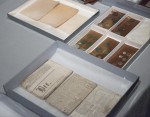 The artifacts and brass box will go on display at the museum after conservation, but only for a short time. The objects will be returned to the cornerstone. Officials haven’t decided yet whether they’ll add yet another round of mementos to the box. Space is tight in there and Governor Patrick said at the opening that he didn’t want to “taint” the historical nature of the capsule with modern geegaws.
The artifacts and brass box will go on display at the museum after conservation, but only for a short time. The objects will be returned to the cornerstone. Officials haven’t decided yet whether they’ll add yet another round of mementos to the box. Space is tight in there and Governor Patrick said at the opening that he didn’t want to “taint” the historical nature of the capsule with modern geegaws.
There’s a nice video of the excavation, X-ray and conservator Pam Hatchfield getting the box opened here. Fair warning: it autoplays. Below is film of the entire opening:
[youtube=http://youtu.be/qGpMM8n3nkE&w=430]